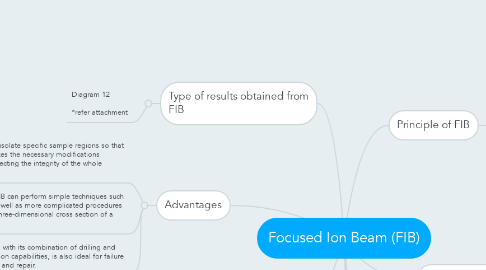Focused Ion Beam (FIB)
by Alia Syahera

1. Type of results obtained from FIB
1.1. Diagram 12 *refer attachment
2. Disadvantages
2.1. causes some undesired damage to the sample
2.2. Main disadvantages of this technique are redeposition of sputtered material, implantation of high amount of Ga (or other metal ions), and amorphization of ~20 nm surface region (at 25 keV)
3. One example application of FIB in nanotechnology.
4. Advantages
4.1. allow it to isolate specific sample regions so that it only makes the necessary modifications without affecting the integrity of the whole sample
4.2. With this technology the FIB can perform simple techniques such as making probe holes as well as more complicated procedures such as cutting a precise three-dimensional cross section of a sample.
4.3. The FIB, with its combination of drilling and deposition capabilities, is also ideal for failure analysis and repair.
5. Principle of FIB
5.1. Focused ion beam, also known as FIB, is a technique used particularly in the semiconductor industry, materials science and increasingly in the biological field for site-specific analysis, deposition, and ablation of materials.
5.2. Focused ion beam (FIB) systems have been produced commercially for approximately twenty years, primarily for large semiconductor manufacturers. FIB systems operate in a similar fashion to a scanning electron microscope (SEM) except, rather than a beam of electrons and as the name implies, FIB systems use a finely focused beam of ions (usually gallium) that can be operated at low beam currents for imaging or high beam currents for site specific sputtering or milling
6. How its works?
6.1. Ions are thousands of times heavier than electrons: Electrostatic fields are more efficient than magnetic fields (electrostatic focusing)
6.2. collection of the scattered ions (ion beam imaging)
6.3. collection of secondary electrons
6.4. implantation of Gallium ions
7. Schematic Diagram of FIB
7.1. Diagram 10 *refer attachment
8. Schematic Diagram how FIB works
8.1. Diagram 11 *refer attachment


